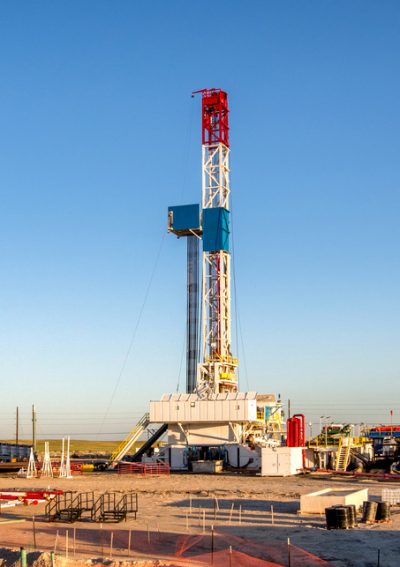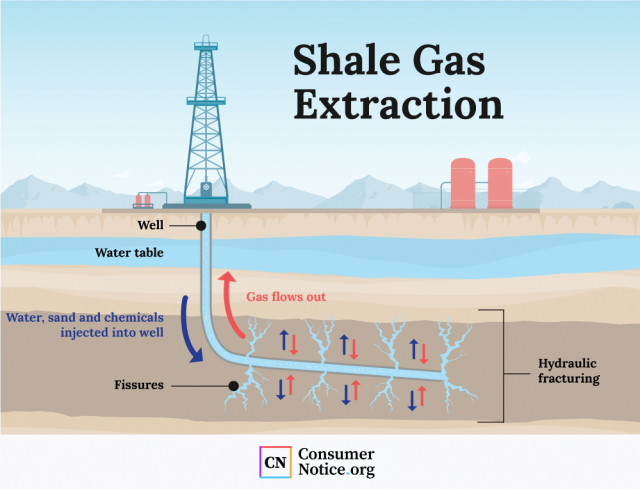Fracking
Hydraulic fracturing, or fracking, is an efficient way for energy companies to extract gas and oil from rock that’s deep underground. Fracking injects high-pressure solutions of water, chemicals and sand into these shale deposits to release the oil and gas. But the popular drilling method is generating lots of controversy because of its links to earthquakes, pollution and other problems.

Contrary to popular thought, fracking isn’t exactly a revolutionary new method of drilling. Forms of fracking have been around since the 1940s, but improvements in technology have made it more feasible for energy companies to retrieve oil and gas that were once inaccessible.
Fracking has significantly increased domestic oil and natural gas production. Between 2007 and 2016, United States oil production grew 75 percent and natural gas production grew 39 percent, according to the Independent Petroleum Association of America. And proponents of the extraction method celebrate the fact that is has driven down natural gas prices.
But as fracking has increased so have concerns about its health and environmental impacts. The controversial process has been linked to water contamination and the disposal of wastewater from fracking has triggered earthquakes. Air pollution, greenhouse gas emissions and threats to worker health are also causing alarm.
Grassroots activism is perhaps the only way to prevent fracking from coming to a neighborhood near you. If you’ve already been harmed by fracking, you may need legal assistance.
What Is Fracking?
The technique of fracking involves injecting liquid and other substances at high pressure into tight shale formations to cause small fractures in the rock. The gas that escapes from these cracks is then captured and stored.
It begins with drilling a well vertically into the earth until it reaches the gas-rich shale layers of rock. At that point — usually at a depth of around 10,000 feet underground — the drill is turned sideways and continues to bore through the shale.
After the drilling is complete, a fracking fluid that contains a mixture of water, sand and chemicals is blasted into the well under extremely high pressure. This forces the fluid into the cracks and crevices of the shale where natural gas is trapped. Because of the immense internal pressure, the petroleum-rich (or gas rich) fluid flows back up to the surface of the well and collects in a tank.

The sand and other solid components in the fracking fluid — also known as proppants — essentially prop up, or keep open, the fractures. This allows the well to continue producing oil and gas for many years. While it takes about three to five days to create a fracking well, according to Coloradans for Responsible Energy Development, most will produce gas or oil for two to four decades.
Why Is Fracking Controversial?
Fracking is controversial because of its detrimental environmental and health impacts. The drilling process has been linked to water contamination and air pollution, and the wastewater disposal process has been associated with an increase in earthquakes in regions where it’s done.
And although a common pro-fracking argument is that gas is a cleaner form of energy than coal when it’s burned, research suggests it may be dirtier than coal in the long run. That’s because the fracking process itself releases large amounts of methane gas into the atmosphere, thus accelerating the greenhouse gas effect and the effects of global climate change.
In a 2011 study published in the journal Climatic Change, Cornell University researchers said fracked wells are belching out at least 30 percent more methane than traditional natural gas wells. Methane is even more detrimental than carbon dioxide (CO2) because methane traps up to 25 times more radiation in the atmosphere than CO2 over a 100-year period.
Robert Howarth, a professor of ecology and environmental biology, told the Cornell Chronicle that the main takeaway from his research is that if you project forward 20 years, gas production from shale is “worse than conventional gas and is, in fact, worse than coal and worse than oil.” Howarth advised that renewable energy is the only good option.
Wastewater Disposal and Earthquakes
Fracking-related activities have also been linked to increased earthquakes in Oklahoma, Texas and other areas where the practice is common. While some small tremors may be related to the fracking process itself, many of the earthquakes are triggered by the injection of wastewater into deep underground wells.
In fact, because of wastewater disposal, Oklahoma now tops California as the most active region in the country for earthquake activity. A decade ago, Oklahoma would experience only one or two earthquakes a year. Today, it experiences thousands of tremors.
Fortunately, most of these quakes are typically around 3.0 or less on the Richter scale, which is below the magnitude people can typically feel. But some are quite significant.
A 5.8 magnitude earthquake near Pawnee, Oklahoma, in September 2016 was the largest ever recorded in the state. It damaged several buildings and was felt as far away as Nebraska and Texas. And it was just one of many. Between 2014 and 2017, the state had 2,409 quakes, according to the Office of the Oklahoma Secretary of Energy and Environment.
The United States Geological Survey, which maintains a myths and misconceptions page on its website, disputes that fracking is causing the rash of frequent “induced earthquakes” in places like Oklahoma. According to the agency, only 1 percent to 2 percent of the earthquakes are linked to hydraulic fracking itself. The rest are caused by wastewater disposal, most of which it says comes from conventional oil drilling.
But some regions are reporting that the fracking process itself is causing tremors. In 2014, the Ohio Department of Natural Resources concluded that fracking had produced tremors southeast of Cleveland in Poland Township. As a result, the state instituted tougher permitting conditions for drilling in regions near faults or known seismic activity.
And Canadian officials concluded that three earthquakes that occurred in Western Canada in late 2018 were caused by the fracturing process itself. According to Global News, the British Columbia Oil and Gas Commission concluded that the earthquakes, which ranged in magnitude from 3.4 to 4.5, were caused by hydraulic fracturing operations being conducted by the Canadian Natural Resources.
In 2018, Canadian researchers published new findings in Geophysical Research Letters that show that injection-induced earthquakes are more common in areas like northern British Columbia where “tectonic strain rate” is high.
In other words, if seismic activity is already significant in a certain area, fracking can increase the chance of an earthquake in the short term. Interestingly, they posed that if more frequent human-induced earthquakes persist over time, it might lead to fewer natural earthquakes in the long term.
Impact on Water
A 2011 study in the journal Environmental Health Perspectives looked at 68 private drinking wells in New York and northeastern Pennsylvania and found elevated levels of methane in those near fracking wells. The study cited a former Pennsylvania state official with the Department of Environmental Protection as saying the methane levels were likely caused by leaking wells, but he could not rule out fracking itself as a potential cause.
Residents of Dimock, Pennsylvania, claimed that their drinking water became contaminated with methane after Cabot Oil & Gas began fracking there in 2007. In some cases, the tap water had so much methane in it that it could be set on fire.
Some Pennsylvania residents filed fracking lawsuits, and a jury awarded two families a $4.2 million verdict. The families reached an undisclosed settlement with Cabot Oil & Gas Co. after a judge threw the verdict out, according to Reuters.
While the health effects of frequent ingestion of methane are unclear, a 2016 report by the Environmental Protection Agency found that some chemicals in fracking fluids are known hazards to humans. Specifically, 173 of the more than 1,600 chemicals identified by the agency in the fracking water cycle were toxic with chronic exposure by mouth.
- When water is removed from areas with limited water availability or low water resources
- When large amounts of fracking fluids and chemicals are spilled or discharged, and those spills reach groundwater or surface water
- When fracking fluids are injected into wells with mechanical problems or directly into groundwater
- When inadequately treated wastewaters are discharged into surface water or stored in pits without liners
The report also included several case studies of drinking water supplies near fracking sites. They included an examination of the water supply in Killdeer, North Dakota, where a fracking well exploded in 2010. The blowout released fracking fluids and water but did not contaminate nearby drinking water wells, according to the agency. However, two monitoring wells did test positive for brine and tert-butyl alcohol, which is a known irritant.
But the agency said it was unable to offer much else in the way of an assessment of how fracking affects water because of a lack of information. It said it hoped its findings would help states better protect drinking water and stimulate conversations among stakeholders.
Air Pollution
Some claim that the fracking boom is also causing air pollution and related health hazards.
A 2014 report from the Natural Resources Defense Council claims that fracking is contributing to an array of dangerous air pollutants including:
- Ozone smog
- Smog can be dangerous to those with respiratory conditions and other health problems.
- Pollutants
- Pollutants, such as formaldehyde, benzene and other toxic hydrocarbons, can aggravate asthma and cause irritation of the eyes, nose and mouth.
- Diesel emissions
- Trucks and heavy machinery involved in fracking can emit diesel emissions that contribute to breathing issues, asthma problems, heart attacks, strokes and other serious issues.
- Silica
- A component of “frac sand,” silica can cause serious lung disease in fracking workers.
The report concluded that fracking activities should be put on hold until comprehensive health assessments can be conducted. In areas were fracking is widespread, safeguards should be instituted to control emissions and limit pollution, the council said.
Fracking Dust
According to the Occupational Safety and Health Administration, the federal agency that oversees worker safety, hydraulic fracturing uses large quantities of silica sand and many workers are ending up with dangerous exposures.
The National Institute for Occupational Safety and Health took 116 air samples from 11 fracking sites in five states to see how much silica workers were encountering. Of the samples taken, 47 percent revealed silica exposures larger than the OSHA permissible exposure limit (PEL), and 79 percent exceeded the National Institute for Occupational Safety and Health recommended exposure limit.
There are many moments in the fracking process when workers can inhale the dust, but OSHA studies showed that mover and blender operators had with the highest silica exposure. But even workers who spent most of their days sitting inside the non-filtered cabs of chemical and blender trucks were exposed to hazardous levels of the dust.
Unfortunately, the toxic effects of silica dust can take a long time to show up. Acute silicosis, which almost always causes disability and death, usually occurs after several months or years of high exposure to silica. Accelerated silicosis appears within five to 10 years and has the same outcome.
Chronic or class silicosis, which is the most common form of the disease, often doesn’t appear for a decade or two. It usually presents with progressive shortness of breath during exertion. In the later stages, an individual may develop shortness of breath and a cough, and it sometimes progresses to respiratory failure.
What You Can Do
If you work for a fracking outfit, it’s important to know that you have rights under the law. Your employer should be providing education about the dangers of silica. And your employer is required to provide you with the proper protection to minimize your health risks.
You can find more information about workers’ exposure to silica in the hazard alert issued by OSHA.
If you are worried about fracking in your community, the Natural Resources Defense Council advises you to get involved on a grassroots level to make your voice heard.
In 2014, New York banned hydraulic fracturing in the Empire State. Though some local counties and towns have also passed fracking bans, they’ve not all been successful in enforcing them and have faced backlash from the energy sector. The Natural Resources Defense Council’s Community Fracking Defense Project helps towns and communities figure out how to protect themselves.
If you believe you or your property or health has been harmed because of fracking, your best bet may be to contact an attorney. A lawyer will help you understand your rights under the law and can advise you of any potential legal recourse. Those who’ve sustained damage to their homes and properties or had their water contaminated may be entitled to compensation.
35 Cited Research Articles
Consumernotice.org adheres to the highest ethical standards for content production and references only credible sources of information, including government reports, interviews with experts, highly regarded nonprofit organizations, peer-reviewed journals, court records and academic organizations. You can learn more about our dedication to relevance, accuracy and transparency by reading our editorial policy.
- BBC. (2018, October 15). What is fracking and why is it controversial? Retrieved from https://www.bbc.com/news/uk-14432401
- Black Mountain Sand. (n.d.). What is Proppant and How is It Used in Fracking? Retrieved from https://www.blackmountainsand.com/what-is-proppant/
- Chen, X. et al. (2017, July 10). The Pawnee earthquake as a result of the interplay among injection, faults and foreshocks. Retrieved from https://www.nature.com/articles/s41598-017-04992-z
- Coloradans for Responsible Energy Development. (n.d.). How Long Does Fracking Last? Retrieved from https://www.cred.org/how-long-does-fracking-last/
- Concerned Health Professionals of New York & Physicians for Social Responsibility. (2018, March). Compendium of Scientific, Medical, and Media Findings Demonstrating Risks and Harms of Fracking (Unconventional Gas and Oil Extraction). Retrieved from http://concernedhealthny.org/wp-content/uploads/2018/03/Fracking_Science_Compendium_5FINAL.pdf
- DeKok, D. (2017, September 26). Cabot Oil Gas settles fracking lawsuit. Retrieved from https://www.reuters.com/article/us-pennsylvania-fracking-cabot-oil-gas/cabot-oil-gas-settles-fracking-lawsuit-with-pennsylvania-families-idUSKCN1C12GO
- Eaton, J. (2013, March 29). Scientists Say Oil Industry Likely Caused Largest Oklahoma Earthquake. Retrieved from https://www.nationalgeographic.com/science/article/130329-wastewater-injection-likely-caused-quake
- Fischetti, M. (2012, January 20). Fracking Would Emit Large Quantities of Greenhouse Gases: “Fugitive Methane” released during shale gas drilling could accelerate climate change. Retrieved from https://www.scientificamerican.com/article/fracking-would-emit-methane/?redirect=1
- Hays, B. (2019, April 26). New research links fracking to earthquakes in central, eastern U.S. Retrieved from https://www.upi.com/Science_News/2019/04/26/New-research-links-fracking-to-earthquakes-in-central-eastern-US/6661556294511/
- Holzman, D.C. (2011, July 1). Methane Found in Well Water Near Fracking Sites. Retrieved from https://ehp.niehs.nih.gov/doi/full/10.1289/ehp.119-a289
- Howarth, R.W., Santoro, R. & Ingraffea, A. (2011). Methane and the greenhouse-gas footprint of natural gas from shale formations. Retrieved from http://www.atkinson.cornell.edu/Assets/ACSF/docs/attachments/Howarth-EtAl-2011.pdf
- Independent Petroleum Association of America. (n.d.). What is Fracking? Retrieved from https://www.ipaa.org/fracking/
- Kaplan, T. (2014, December 17). Citing Health Risks, Cuomo Bans Fracking in New York State. Retrieved from https://www.nytimes.com/2014/12/18/nyregion/cuomo-to-ban-fracking-in-new-york-state-citing-health-risks.html
- Kao, H. et al. (2018, October 11). Induced Seismicity in Western Canada Linked to Tectonic Strain Rate: Implications for Regional Seismic Hazard. Retrieved from https://agupubs.onlinelibrary.wiley.com/doi/10.1029/2018GL079288
- Kelso, M. (2015, August 3). 1.7 Million Wells in the U.S. A 2015 Update. Retrieved from https://www.fractracker.org/2015/08/1-7-million-wells/
- Little, S. (2018, December 22). Fort St. John earthquakes were caused by fracking: BC Oil and Gas Commission. Retrieved from https://globalnews.ca/news/4789210/fort-st-john-frackqing-earthquakes/
- McAllister, E. (2014, April 11). Ohio Links Fracking to Earthquakes, Announces Tougher Rules. Retrieved from https://www.scientificamerican.com/article/ohio-links-fracking-to-earthquakes-announces-tougher-rules/?print=true
- Nunez, C. (2019, May 20). How Has Fracking Changed Our Future? Retrieved from https://www.nationalgeographic.com/environment/energy/great-energy-challenge/big-energy-question/how-has-fracking-changed-our-future/
- NRDC. NRDC Issue Brief/Fracking Fumes: Air Pollution from Hydraulic Fracturing Threatens Public Health and Communities. Retrieved from https://www.nrdc.org/sites/default/files/fracking-air-pollution-IB.pdf
- NRDC. (n.d.). Reduce Fracking Health Hazards. Retrieved from https://www.nrdc.org/issues/reduce-fracking-health-hazards
- Office of the Oklahoma Secretary of Energy & Environment. (n.d.). Earthquakes in Oklahoma. Retrieved from https://earthquakes.ok.gov/
- Occupational Health and Safety Administration. (2012, June). Worker Exposure to Silica During Hydraulic Fracturing. Retrieved from https://www.osha.gov/sites/default/files/publications/hydraulic_frac_hazard_alert.pdf
- Ohio Department of Natural Resources. (2014, April 11). Ohio Announced Tougher Permit Conditions for Drilling Activities Near Faults and Areas of Seismic Activity. Retrieved from http://ohiodnr.gov/news/post/ohio-announces-tougher-permit-conditions-for-drilling-activities-near-faults-and-areas-of-seismic-activity
- Pappas, S. (2018, April 25). Oklahoma Suffers Its 2,734th Earthquake Since 2010. Retrieved from https://www.livescience.com/62410-oklahoma-earthquakes-wastewater-injection.html
- Shackford, S. (2011, April 11). Natural gas from fracking could be ‘dirtier’ than coal, Cornell professors find. Retrieved from https://news.cornell.edu/stories/2011/04/fracking-leaks-may-make-gas-dirtier-coal
- Scheiner, E. & Foley, C. (2015, March 18). Fracking, Earthquakes and Insurance: A Collision Course? Retrieved from https://www.insurancejournal.com/magazines/mag-features/2015/05/18/367654.htm
- The Associated Press. (2016, September 3). Strong Oklahoma Earthquake Felt from Nebraska to Texas. Retrieved from https://www.nbcnews.com/news/us-news/strong-oklahoma-earthquake-felt-nebraska-texas-n642386
- U.S. Environmental Protection Agency. (2016). EPA's Study of Hydraulic Fracturing and Its Potential Impact on Drinking Water Resources/Hydraulic Fracturing for Oil and Gas: Impacts from the Hydraulic Fracturing Water Cycle on Drinking Water Resources in the United States (Final Report). Retrieved from https://cfpub.epa.gov/ncea/hfstudy/recordisplay.cfm?deid=332990
- U.S. Environmental Protection Agency. (n.d.). Greenhouse Gas Emissions: Overview of Greenhouse Gases (Methane Emissions). Retrieved from https://www.epa.gov/ghgemissions/overview-greenhouse-gases
- U.S. Environmental Protection Agency. (2016, December 13). Hydraulic Fracturing for Oil and Gas Impacts From the Hydraulic Fracturing Water Cycle on Drinking Water Resources in the United States, Retrieved from https://www.epa.gov/sites/production/files/2016-12/documents/hfdwa_briefing_20161212_final_508_km.pdf
- U.S. Environmental Protection Agency. (n.d.). Retrospective Case Studies — Killdeer, North Dakota (Dunn County) EPA’s Study on the Potential Impacts of Hydraulic Fracturing for Oil and Gas on Drinking Water Resources. Retrieved from https://www.epa.gov/sites/production/files/2015-06/documents/final_killdeer_nd_fact_sheet_6_03_508_km.pdf
- U.S. Geological Survey. (n.d.). Induced Earthquakes: Myths & Misconceptions. Retrieved from https://www.usgs.gov/natural-hazards/earthquake-hazards/induced-earthquakes?qt-science_support_page_related_con=4#qt-science_support_page_related_con
- U.S. Geological Survey. (2016, September 7). Magnitudes for Oklahoma Earthquakes Shift Upward. Retrieved from https://www.usgs.gov/news/magnitudes-oklahoma-earthquakes-shift-upward
- U.S. Geological Survey. (n.d.). Oklahoma now has more earthquakes on a regular basis than California. Are they due to fracking? Retrieved from https://www.usgs.gov/faqs/oklahoma-has-had-a-surge-earthquakes-2009-are-they-due-fracking?qt-news_science_products=0#qt-news_science_products
- Whaley, S. (2017, April 6). Bill would ban most fracking in Nevada. Retrieved from https://www.reviewjournal.com/news/2017-legislature/bill-would-ban-most-fracking-in-nevada/
Calling this number connects you with a Consumer Notice, LLC representative. We will direct you to one of our trusted legal partners for a free case review.
Consumer Notice, LLC's trusted legal partners support the organization's mission to keep people safe from dangerous drugs and medical devices. For more information, visit our partners page.
844-420-1914
